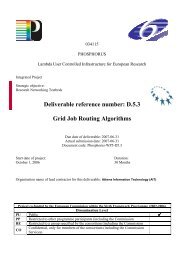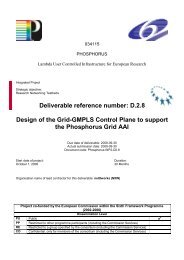D5.9: Extended Simulation Environment - Phosphorus
D5.9: Extended Simulation Environment - Phosphorus
D5.9: Extended Simulation Environment - Phosphorus
You also want an ePaper? Increase the reach of your titles
YUMPU automatically turns print PDFs into web optimized ePapers that Google loves.
D5.6 - <strong>Extended</strong> <strong>Simulation</strong> <strong>Environment</strong><br />
To implement the grid specific functionality, several classes are implemented which are derived from the base<br />
classes described above, such as ClientNode, ResourceNode, Switch. For more information regarding the<br />
architecture of the simulator we refer to [1].<br />
4.3 Optimization and additional feature<br />
4.3.1 Jung library<br />
In the first version of the simulator we implemented our own graph representation structures and graph related<br />
algorithms. For example, we implemented from scratch the Dijkstra algorithm, so as to find the shortest path<br />
from node A to node B. However, this requires a significant programming effort, while several libraries are<br />
available that already implemented such functionality. As a result, in the context of the present deliverable, we<br />
decided to integrate one of these libraries, namely the JUNG [4], in our simulator.<br />
JUNG (Java Universal Network/Graph Framework) is a software library that provides a common and extensible<br />
language for the modelling, analysis, and visualization of data that can be represented as a graph or network.<br />
This library is incorporated in our software in such a way that the user of the simulator does not need to know<br />
how to use it. JUNG also provides a visualization framework that makes it easy to construct tools for the<br />
interactive exploration of network data.<br />
4.3.2 Hybrid switching – Burst over Circuit Switching<br />
The main update from the previous version of the simulator is that it is now able to model the Burst-Over-Circuit<br />
switching technique 1 [5]. This became possible by the introduction of the HybridSender class, which takes care<br />
of the switching technique used by an entity. This sender is a composition of two other senders: namely an<br />
OCSSender and an OBSSender. First, the HybridSender tries to send the data using the OCSSender, in order<br />
to take advantage of an already established OCSCircuit. If this is not possible, there are two remaining<br />
possibilities, namely:<br />
1. We have reached the beginning of an OCScircuit and the data must be conveyed on this circuit.<br />
2. There are no circuits available and the OBS switching technique should be used to forward the data.<br />
This execution flow can bee seen in Figure 4.<br />
1 In the Burst-Over-Circuit-Switching model, the circuit switched network technology works as a server layer<br />
providing a virtual topology with light paths to a burst switching client layer. Optical bursts are only switched in the<br />
client layer nodes and transparently flows in light paths through the server layer nodes.<br />
Project:<br />
<strong>Phosphorus</strong><br />
Deliverable Number: <br />
Date of Issue: 2009-03-31<br />
EC Contract No.: 034115<br />
Document Code: <br />
21






